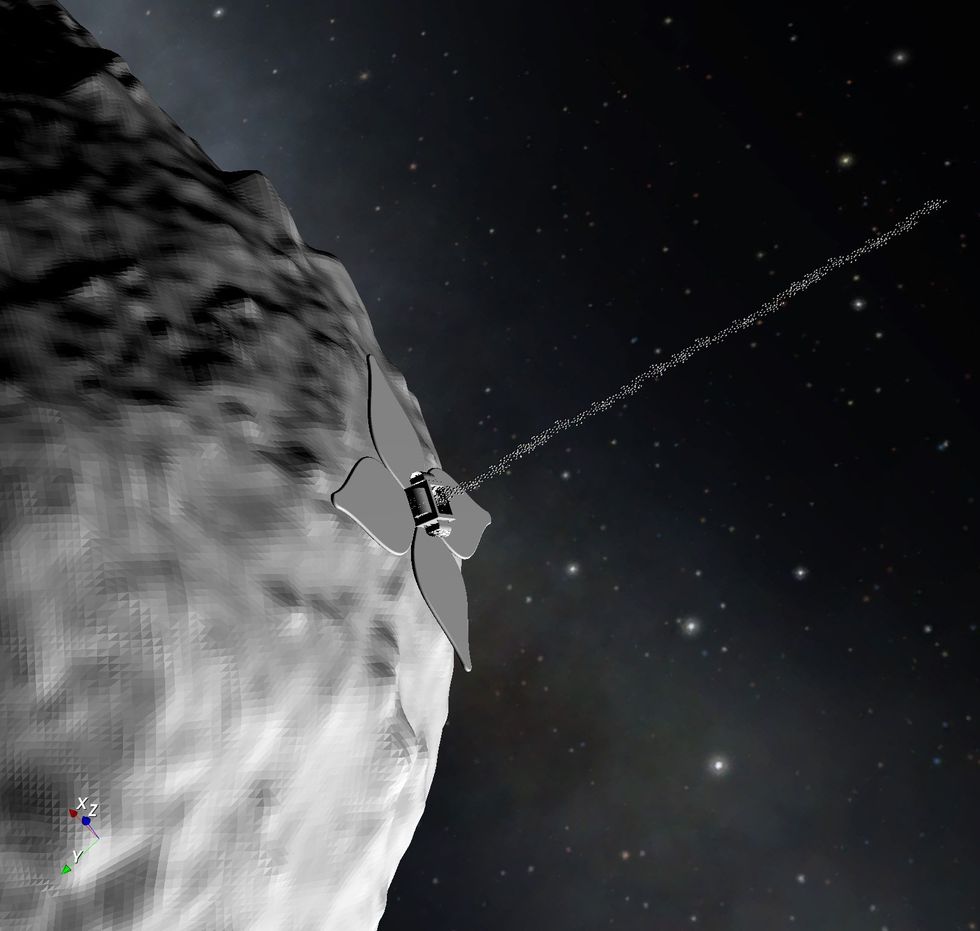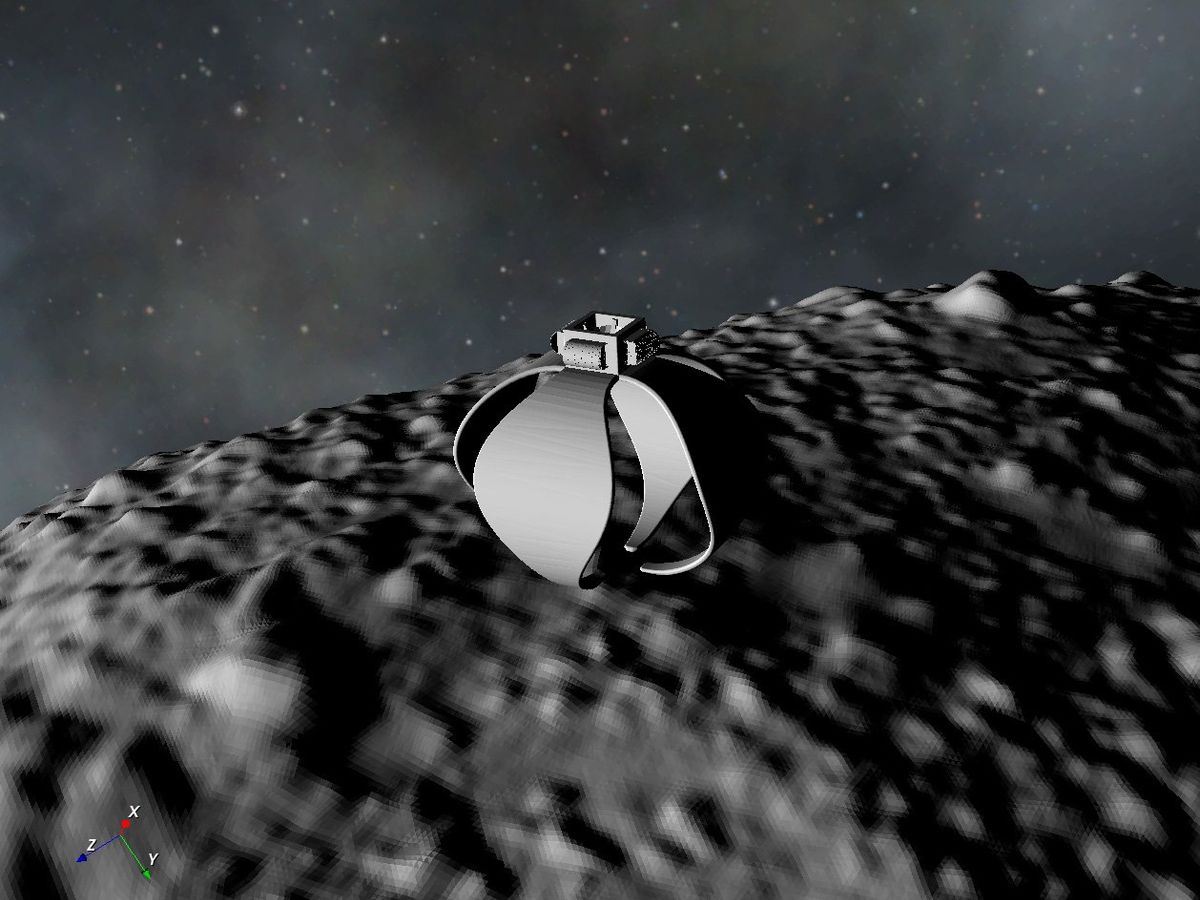How do you land on an asteroid? A lot of very talented engineers have thought about it. Putting a robotic spacecraft down safely on a moon or planet is hard enough, with the pull of gravity to keep you humble. But when it comes to an asteroid, where gravity may be a few millionths of what it is on Earth, is “landing” even the right word?
NASA’s OSIRIS-REx mission is due back on Earth on 24 September after a seven-year voyage to sample the regolith of the asteroid 101955 Bennu—and in that case, mission managers decided not even to risk touching down on Bennu’s rocky crust. “We don’t want to deal with the uncertainty of the actual contact with the surface any longer than necessary,” said Mike Moreau, the deputy mission manager, back in 2020. They devised a scheme to poke the asteroid with a long sampling arm; the ship spent more than two years orbiting Bennu and all of 16 seconds touching it.
Maybe landing is a job for a softbot—a shape-shifting articulated spacecraft of the sort that Jay McMahon and colleagues at the University of Colorado in Boulder have been working on for more than six years. You can call them AoES—short for Area-of-Effect Softbots. The renderings of one resemble a water lily.
That’s not entirely by accident. A bit like a floating lily, the softbot has a lot of surface area relative to its mass. So, if there isn’t much gravity to work with, it can maneuver using much smaller forces—such as electro-adhesion, solar radiation, and van der Waals attraction between molecules. (If you’re not familiar with van der Waals forces, think of a gecko sticking to a wall.)
“There are electrostatic forces that will act and are not insignificant in the asteroid environment,” says McMahon. “It’s just a weird place, where gravity is so weak that those forces that exist on Earth, which we basically ignore because they’re so insignificant—you can take advantage of them in interesting ways.”
It’s important to say, before we go further, that space softbots are a long-term idea, on the back burner for now. McMahon’s team got some funding in 2017 from NIAC, the NASA Innovative Advanced Concepts program; more recently they’ve been researching whether they can apply some of their technology to on-orbit servicing of satellites or removal of space junk. McMahon has also been a scientist on other missions, including OSIRIS-REx and DART, which famously crashed into a small asteroid last year to change the asteroid’s orbital path.
A problem with small asteroids is that many of them—perhaps most—aren’t solid boulders. If they are less than 10 kilometers in diameter, the chances are high that they are so-called rubble piles—agglomerations of rock, metal, and perhaps ice that are held together, in part, by the same weak forces AoES probes would use to explore them. Rubble piles are risky for spacecraft: When OSIRIS-REx gently bumped the surface of Bennu with its sampling arm, scientists were surprised to see that it broke right through with minimal resistance, sending a shower of rock and dirt in all directions.
An even softer approach may be in order, if you want to set a robot down on a rubble pile asteroid. If you’re going to explore the asteroid or perhaps mine it—you need a way to approach it, then settle on the surface without making a mess of it. Early missions tried harpoons and thrusters, and had a rough time.

“You need to find a way to hold yourself down, but you also need to find a way to not sink in if it’s too soft,” says McMahon. “And so that’s where this big-area idea came from.”
McMahon and his team wrote in a 2018 report for NASA that they can envision a softbot, or a fleet of them, flown into orbit around an asteroid by a mother ship. The petals might be made partly of silicone elastomers, flexible material that has been used on previous spacecraft. In early renditions the petals were a large disc; the flower design turned out to be more efficient. When they’re spread out straight (perhaps extending a few meters), they could act as a solar sail of sorts, slowly guiding the softbot to the surface and curling up to cushion the landing if necessary. Then they could change shape to conform to the asteroid’s own, perhaps attracting themselves to it naturally with van der Waals forces, supplemented with a small electrical charge.
The charge need not be very strong; more important is that the petals be large enough that, when spread out over the surface, they cumulatively create a good grip. McMahon and his colleagues suggest the charge could be turned on and off with HASEL (short for Hydraulically Amplified Self-Healing Electrostatic) actuators, perhaps only affecting one part of a petal at a time.
What about actually digging into the asteroid or kicking up rock for the mother ship to recover? The limbs should hold the spacecraft down while a sampling tool does its work. What if your spacecraft lands in a bad place, or you want to move on to another part of the asteroid? Bend the petals and the softbot can crawl along, a little like a caterpillar. If necessary, the spacecraft can slowly “hop” from one spot to another, straightening its petals again as solar sails to steer. Importantly, they operate without using much fuel, which is heavy, limited in quantity, and probably not something you want contaminating the asteroid.
Though the Colorado team was very thorough in designing their softbot concept, there are obviously countless details still to be worked out—issues of guidance, navigation, power, mass, and many others, to say nothing of the economics and political maneuvering needed to launch a new technology. AoES vehicles as currently designed may never fly, but ideas from them may find their way into spacecraft of the future. In McMahon’s words, “This concept elegantly overcomes many of the difficulties.”
- Coming Home: NASA’s OSIRIS-REx Asteroid Mission to Begin Return from Deep Space ›
- Asteroid-Mining Firm's First Spacecraft Deploys from Space Station ›
Ned Potter is a New York writer who spent more than 25 years as an ABC News and CBS News correspondent covering science, technology, space, and the environment.



